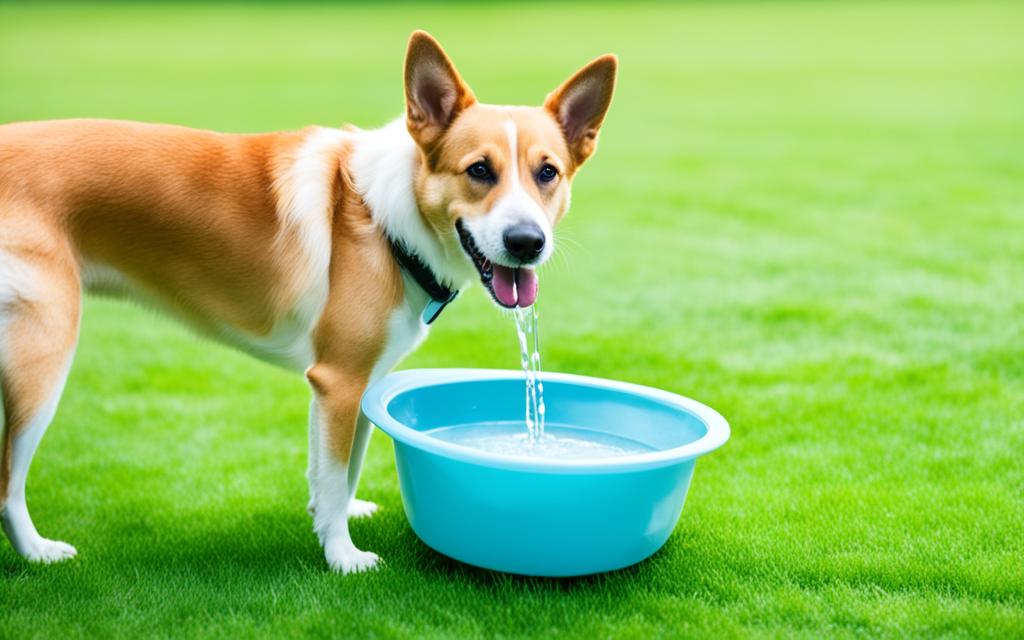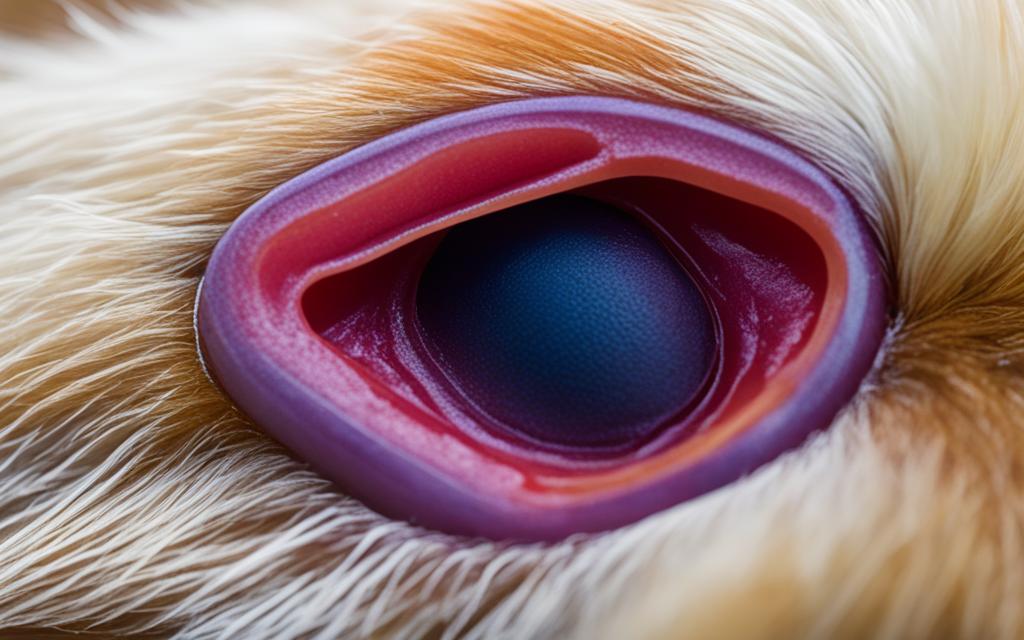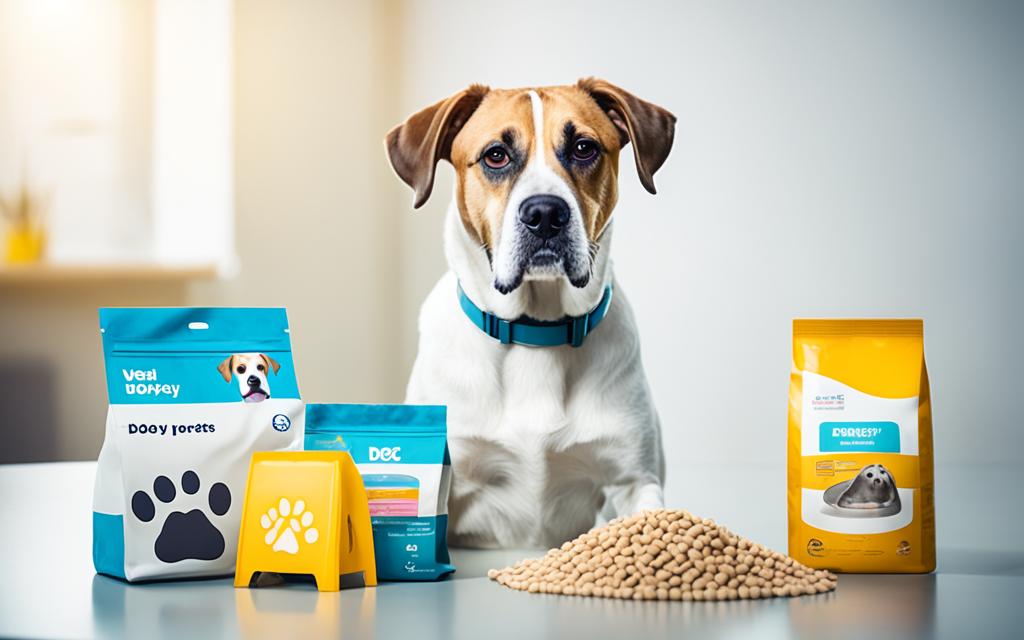Urinary tract infections, or UTIs, are a big health issue for dogs. As pet owners, knowing about your dog’s urinary health is key. If left untreated, these infections can cause a lot of pain and lead to bigger problems. We want to help you understand how to stop UTIs in dogs and treat them if they happen.
This article will cover prevention, symptoms, and treatment options. By learning about these, you can help keep your dog healthy and happy.
Understanding Urinary Tract Infections in Dogs
Urinary tract infections, or UTIs, are common in dogs. They can happen to dogs of all breeds and ages. It’s important for owners to know about dog UTI causes. This knowledge helps catch the problem early and prevent serious issues.
Female dogs get UTIs more often than males because their urethra is shorter. This makes it easier for bacteria to get in. Other things can also make dogs more likely to get UTIs. For example, urinary stones, certain body shapes, and health problems can increase the risk.
It’s key to know the signs of UTI in dogs. Look out for frequent urination, straining when they pee, and blood in the urine. Seeing these signs means you should get your dog to the vet fast. This can help keep your dog comfortable and healthy.
| Dog UTI Causes | Symptoms of UTI in Dogs |
|---|---|
| Bacterial infections | Frequent urination |
| Anatomical anomalies | Straining to urinate |
| Urinary stones | Blood in urine |
| Underlying health conditions | Foul-smelling urine |
Signs and Symptoms of UTI in Dogs
Knowing the signs of a UTI in dogs is key to keeping your pet healthy. Dogs with urinary tract infections show various symptoms. It’s important for owners to watch for these signs.
- Frequent urination, even if only small amounts are produced.
- Straining to urinate, which may indicate discomfort.
- Blood present in the urine, usually visible as a change in color.
- Foul-smelling urine that seems unusually strong.
- Excessive licking of the genital area, suggesting irritation.
Spotting these signs early is crucial. It helps pet owners get their pets the care they need quickly. This can prevent more serious problems later.
| Symptom | Description |
|---|---|
| Frequent Urination | Dog needs to urinate more often than usual. |
| Straining | Dog struggles or appears to have difficulty urinating. |
| Blood in Urine | Urine may appear pink or red, indicating possible infection. |
| Foul Smell | Urine has a strong, unpleasant odor. |
| Behavioral Changes | Increased licking of the genital area or signs of discomfort. |
Knowing these signs of UTIs in dogs helps pet owners act fast. This keeps their pets healthy and happy.
How to Prevent and Treat Dog Urinary Tract Infections
Keeping your dog’s urinary system healthy is key to avoiding urinary tract infections (UTIs). Simple actions like making sure your dog drinks enough water and eating a balanced diet can really help. Regular vet visits are also crucial for checking on your dog’s health. They help catch any problems early.
Importance of Hydration and Diet
Drinking enough water helps dilute your dog’s urine. This makes it harder for bacteria to stick around and cause UTIs. Here are some ways to make sure your dog stays hydrated:
- Provide fresh water at all times.
- Incorporate wet food into your dog’s diet.
- Use water fountains to encourage drinking.
Feeding your dog a balanced diet is also important for their urinary health. Choose high-quality dog food that boosts their immune system. Foods packed with antioxidants and omega fatty acids are great for preventing UTIs. Here’s a table that shows which foods help and which ones might not.
| Food Type | Effects on Urinary Health |
|---|---|
| High-Quality Kibble | Promotes overall health and hydration |
| Canned Wet Food | Increases fluid intake and nutrients |
| Homemade Diets | Can be tailored for individual needs |
| Processed Treats | May contain additives that irritate the bladder |
| High-Sodium Foods | Can lead to dehydration and urinary issues |
Regular Vet Check-ups
Seeing the vet regularly is key for your dog’s bladder health. These visits let you catch problems early and get help right away. Vets can do urine tests and check for any health changes. Getting your pet the care they need helps them live a long, healthy life.

Common Risk Factors for UTIs in Dogs
It’s important to know the common risk factors for urinary tract infections (UTIs) in dogs. Some dogs are more likely to get these infections because of their breed and age. Knowing these factors helps owners take better care of their pets.
Breed Predisposition
Some dog breeds are more likely to get urinary tract problems. These include:
- Yorkshire Terriers
- Shih Tzus
- Poodles
- Boston Terriers
- Cocker Spaniels
These breeds often have traits that make them more likely to get UTIs. Knowing this can help owners prevent these problems.
Age and Health Status
Age and health also affect a dog’s risk of UTIs. Older dogs may have weaker immune systems, making them more likely to get infections. Health issues can also increase these risks:
- Older dogs face more risks due to changes in their bodies.
- Some breeds are more likely to get UTIs as they age.
- Conditions like diabetes or kidney problems can make UTIs more likely.
Understanding how breed, age, and health affect UTI risks is key for dog owners. With this knowledge, they can protect their pets’ urinary health better.
Treatment Options for Dog Urinary Tract Infections
When a dog gets a urinary tract infection (UTI), there are many ways to treat it. It’s important to know about both vet-prescribed treatments and home remedies. Each has its own benefits for pet owners to consider.
Antibiotic Therapy
Antibiotics are often the first choice for treating dog UTIs. Vets pick medicines that target the specific bacteria causing the infection. Common antibiotics include amoxicillin, enrofloxacin, and trimethoprim-sulfamethoxazole. It’s key to finish the whole course of antibiotics to avoid the infection coming back or making bacteria resistant to antibiotics.
Home Remedies for UTIs
Some pet owners look for other ways to help their dogs with UTIs, besides vet care. Home remedies can ease symptoms and work with vet treatments. Here are some common ones:
- Cranberry supplements, thought to stop bacteria from sticking to the bladder.
- Probiotics to keep the gut healthy.
- Drinking more water to clean the urinary tract.
Always talk to a vet before trying home remedies, as they shouldn’t replace medical treatment. Using both approaches helps pets get better faster.
The Role of Diet in UTI Prevention
Diet is key in stopping urinary tract infections (UTIs) in dogs. Eating right can boost your dog’s health and lower UTI risk. Choosing the right foods helps with urinary health, and avoiding bad foods can stop infections.
Foods to Include
Adding the best foods for your dog’s urinary health gives them important nutrients and keeps them hydrated. Think about these options:
- High-water-content vegetables like cucumbers and carrots that keep your dog hydrated.
- Lean proteins such as chicken or turkey, which help maintain muscle health.
- Specially formulated dog foods designed for urinary care, often with lower magnesium and phosphorus levels.
- Cranberries, which may help prevent bacteria from adhering to the bladder walls.
Foods to Avoid
It’s also crucial to avoid certain foods that are bad for your dog’s urinary tract health. Stay away from:
- Processed foods high in salt, which can lead to dehydration.
- Artificial additives that can irritate the urinary tract.
- Low-quality fillers, which provide minimal nutritional value and may contribute to unhealthy urinary conditions.

Maintaining Good Hygiene for Your Dog
Keeping your dog clean is key to lowering the chance of urinary tract infections. A clean dog is happier and healthier. Regular grooming is a big part of keeping your pet healthy. Paying extra attention to areas like the genitals helps stop bacteria from building up and causing infections.
Regular Grooming Tips
Grooming your dog regularly means brushing, washing, and checking for any signs of irritation or infection. Here are some tips to keep your dog healthy:
- Brush your dog’s coat at least once a week to remove loose hair and dirt.
- Inspect the ears, eyes, and skin regularly for cleanliness and health.
- Use a damp cloth to gently clean your dog’s face and paws after outdoor activities.
- Pay special attention when grooming to avoid matting, which can shelter bacteria.
Bathing and Cleaning
Keeping your dog clean and bathing them regularly is important for their hygiene. Here’s how to bathe your dog effectively:
- Choose a dog-friendly shampoo to prevent skin irritation.
- Ensure the water temperature is comfortable; lukewarm water is best.
- Thoroughly rinse off all shampoo, paying attention to the genital area for cleaning a dog’s genitals.
- Dry your dog properly to prevent moisture accumulation in the fur.
Following these grooming and cleaning tips helps dog owners keep their pets healthy and lowers the risk of infections. A routine that focuses on good hygiene keeps your furry friend clean and healthy.
When to Consult a Veterinarian
Knowing when to take your dog to the vet is key, especially for urinary tract infections. Spotting the signs early helps avoid bigger problems and gets your pet better faster.
- Frequent urination or straining to urinate
- Blood in the urine or abnormal urine color
- Unusual odor coming from the urine
- Excessive licking of the genital area
- Signs of distress or discomfort while urinating
- Behavioral changes, such as lethargy or loss of appetite
If you see any of these signs, it’s time for a vet check-up. Waiting too long can cause bigger issues like kidney infections or bladder damage. Regular vet visits help catch urinary tract problems early, even if your dog seems fine. Your vet can give advice and early treatment to keep your dog healthy.
Conclusion
Keeping your dog’s urinary tract healthy is key to their overall health. We’ve looked at why preventing UTIs in dogs is important and how owners can help. By making sure they drink enough water and eat right, and knowing the signs of UTIs, owners can keep their dogs healthy.
It’s important to take your dog to the vet regularly for check-ups. This helps catch any health problems early. By paying attention to your dog’s behavior and health, you can spot issues before they get worse. Taking care of your dog’s urinary system means making good lifestyle choices, taking preventive steps, and going for regular vet visits.
With the right steps, like feeding them well and keeping them clean, you can prevent UTIs. This means your dog can stay happy and healthy. Taking care of your dog’s urinary tract health strengthens your bond and makes their life better.




